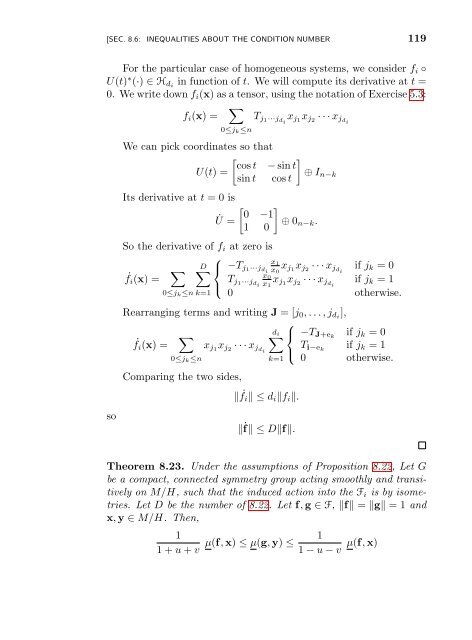Nonlinear Equations - UFRJ
Nonlinear Equations - UFRJ
Nonlinear Equations - UFRJ
Create successful ePaper yourself
Turn your PDF publications into a flip-book with our unique Google optimized e-Paper software.
[SEC. 8.6: INEQUALITIES ABOUT THE CONDITION NUMBER 119<br />
For the particular case of homogeneous systems, we consider f i ◦<br />
U(t) ∗ (·) ∈ H di in function of t. We will compute its derivative at t =<br />
0. We write down f i (x) as a tensor, using the notation of Exercise 5.3:<br />
f i (x) =<br />
∑<br />
T j1···j di<br />
x j1 x j2 · · · x jdi<br />
so<br />
0≤j k ≤n<br />
We can pick coordinates so that<br />
[ ]<br />
cos t − sin t<br />
U(t) =<br />
⊕ I<br />
sin t cos t n−k<br />
Its derivative at t = 0 is<br />
˙U =<br />
[ ]<br />
0 −1<br />
⊕ 0<br />
1 0 n−k .<br />
So the derivative of f i at zero is<br />
⎧<br />
f˙<br />
i (x) =<br />
∑<br />
x<br />
D∑ ⎨ −T 1 j1···j di x 0<br />
x j1 x j2 · · · x jdi if j k = 0<br />
x<br />
T 0 j1···j<br />
⎩<br />
di x 1<br />
x j1 x j2 · · · x jdi if j k = 1<br />
0≤j k ≤n k=1 0 otherwise.<br />
Rearranging terms and writing J = [j 0 , . . . , j di ],<br />
⎧<br />
f˙<br />
i (x) =<br />
∑<br />
∑d i ⎨ −T J+ek if j k = 0<br />
x j1 x j2 · · · x jdi T i−ek if j k = 1<br />
⎩<br />
0≤j k ≤n<br />
k=1 0 otherwise.<br />
Comparing the two sides,<br />
‖ ˙ f i ‖ ≤ d i ‖f i ‖.<br />
‖ḟ‖ ≤ D‖f‖.<br />
Theorem 8.23. Under the assumptions of Proposition 8.22, Let G<br />
be a compact, connected symmetry group acting smoothly and transitively<br />
on M/H, such that the induced action into the F i is by isometries.<br />
Let D be the number of 8.22. Let f, g ∈ F, ‖f‖ = ‖g‖ = 1 and<br />
x, y ∈ M/H. Then,<br />
1<br />
1 + u + v µ(f, x) ≤ µ(g, y) ≤ 1<br />
1 − u − v<br />
µ(f, x)

















